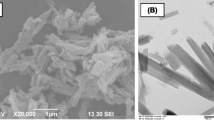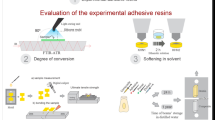Abstract
The adhesive systems have the function to establish the connection between the restorative material and dental tissue, therefore it is of fundamental importance, because failures in the adhesive interface can reduce the life of a dental restoration. This study investigated the possibility of using the adhesive layer as a chlorhexidine modified release system evaluating their impact on the properties of these systems as well as evaluating the impact of these systems on immediate and post-aging dentin adhesion. Were used a matrix with BisGMA, UDMA, HEMA and TEGDMA copolymer and clay particles (Dellite 67G); associated with a chlorhexidine and a camphorquinone photoinitiator system. The properties of these systems were evaluated by the XRD, FTIR spectrophotometer, flexural strength, elasticity modulus, drug release, enzymatic inhibition and dentin adhesion resistance. The presence of the clay can raise the mechanical properties of the adhesive systems engendering a more resistant hybrid layer and led to a more sustained release of chlorhexidine in the systems, allowing a longer effective period of MMP-2 inhibition. The hypothesis that the addition of clays as release modulators could increase the effectiveness of these drugs in inhibiting the dentin’s MPPs and consequently enhancing the adhesive durability was confirmed. These results indicate that the controlled release of chlorhexidine is able to reduce the process of loss of adhesion presenting itself as a promising system to increase the longevity of dental restorations.







Similar content being viewed by others
Change history
05 March 2020
An amendment to this paper has been published and can be accessed via a link at the top of the paper.
05 March 2020
An amendment to this paper has been published and can be accessed via a link at the top of the paper.
References
Miletic V, Sauro S. Bonding to tooth tissues. In: Dental composite materials for direct restorations 1. New York: Springer Publishing; 2018. p. 199–218.
Montagner AF, Opdam NJ, De Munck J, Cenci MS, Van Meerbeek B, Huysmans MCD. Bonding efficacy and fracture pattern of adhesives submitted to mechanical aging with the Rub & Roll device. J Adhes Dent. 2017;19:59–8.
Tezvergil-Mutluay A. Tooth as an adhesive substrate for fiber-reinforced composites. In: A clinical guide to fibre reinforced composites (FRCs) in dentistry. England: Woodhead Publishing; 2017. p. 79–96.
Zhang Z, Mutluay M, Tezvergil-Mutluay A, Tay FR, Pashley DH, Arola D. Effects of EDC crosslinking on the stiffness of dentin hybrid layers evaluated by nano DMA over time. Dent Mater. 2017;33:904–14.
Pashley DH, Tay FR, Yiu C, Hashimoto M, Breschi L, Carvalho RM et al. Collagen degradation by Host-derived enzymes during aging. J Dent Res. 2004;83:216–21.
Moon PC, Weaver J, Brooks CN. Review of matrix metalloproteinases’ effect on the hybrid dentin bond layer stability and chlorhexidine clinical use to prevent bond failure. J Oper Dent. 2010;4:147–52.
Maravic T, Mazzoni A, Comba A, Scotti N, Checchi V, Breschi L. How stable is dentin as a substrate for bonding? Curr Oral Health Rep. 2017;4:248–57.
Sebold M, André CB, Ambrosano GMB, Nascimento FD, Giannini M. Bond strength and adhesive interface analysis using EDTA as a dentin conditioner. Int J Adhes Adhes. 2017;77:157–63.
Bravo C, Sampaio CS, Hirata R, Puppin-Rontani RM, Ricardo Mayoral J, Giner L. In-vitro comparative study of the use of 2% chlorhexidine on microtensile bond strength of different dentin adhesives: a 6 months evaluation. Int J Morphol. 2017;35:893–900.
Breschi L, Mazzoni A, Nato F, Carrilho M, Visintini E, Tjäderhane L et al. Chlorhexidine stabilizes the adhesive interface: a 2-year in vitro study. Dent Mater. 2010;26:320–5.
Favetti M, Schroeder T, Montagner AF, Correa MB, Pereira-Cenci T, Cenci MS. Effectiveness of pre-treatment with chlorhexidine in restoration retention: a 36-month follow-up randomized clinical trial. J Dent 2017;60:44–9.
Mazzoni A, Scaffa P, Carrilho M, Tjäderhane L, Di Lenarda R, Polimeni A et al. Effects of etch-and-rinse and self-etch adhesives on dentin MMP-2 and MMP-9. J Dent Res. 2013;92:82–6.
Priyadarshini BM, Mitali K, Lu TB, Handral HK, Dubey N, Fawzy AS. PLGA nanoparticles as chlorhexidine-delivery carrier to resin-dentin adhesive interface. Dent Mater. 2017;33:830–46.
Meirelles LMA, Raffin FN. Clay and polymer-based composites applied to drug release: a scientific and technological prospection. J Pharm Pharm Sci 2017;20:115–34.
Atai M, Solhi L, Nodehi A, Mirabedini SM, Kasraei S, Akbari K et al. PMMA-grafted nanoclay as novel filler for dental adhesives. Dent Mater. 2009;25:339–47.
Menezes LR, Silva EO. The use of montmorillonite clays as reinforcing fillers for dental adhesives. Mater Res. 2016;19:236–42.
Solhi L, Atai M, Nodehi A, Imani M, Ghaemi A, Khosravi K. Poly (acrylic acid) grafted montmorillonite as novel fillers for dental adhesives: Synthesis, characterization and properties of the adhesive. Dent Mater. 2012;28:369–77.
ISO 4049:2000. Depth of cure, Class 2 materials. In: Dentistry—polymer-based filling, restorative and luting materials. Switzerland: International Organization for Standardization; 2000.
Kevadiya BD, Bajaj HC. The layered silicate, montmorillonite (MMT) as a drug delivery carrier. In: Key engineering materials. Switzerland: TransTech Publications; 2013. p. 111–132.
Bertolini MM, Portela MB, Curvelo JAR, Soares RM, Lourenço EJ, Telles DM. Resins-based denture soft lining materials modified by chlorhexidine salt incorporation: an in vitro analysis of antifungal activity, drug release and hardness. Dent Mater. 2014;30:793–8.
Marchesi G, Breschi L, Antoniolli F, Di Lenarda R, Ferracane J, Cadenaro M. Contraction stress of low-shrinkage composite materials assessed with different testing systems. Dent Mater. 2010;26:947–53.
Merino D, Ludueña LN, Alvarez VA. Dissimilar tendencies of innovative green clay organo-modifier on the final properties of poly (ε-caprolactone) based nanocomposites. J Polym Environ. 2017;1:1–12.
Kumar P, Mohan C, Kanamsrinivasan UMA, Shankar M, Gulati M. Physiochemical characterization and release rate studies of solid dispersions of ketoconazole with pluronic F127 and PVP K-30. Iran J Pharm Res. 2011;10:85–694.
Cocco AR, Lima GS, Leal FB, Munchow EA, Ogliari FA, Piva E. Addition of nanoparticles for development of radiopaque dental adhesives. Int J Adhes Adhes. 2018;80:122–7.
Cadenaro M, Pashley DH, Marchesi G, Carrilho M, Antoniolli F, Mazzoni A et al. Influence of chlorhexidine on the degree of conversion and E-modulus of experimental adhesive blends. Dent Mater. 2009;25:1269–74.
Carrilho MR, Carvalho RM, Tay FR, Pashley DH. Effects of storage media on mechanical properties of adhesive systems. Am J Dent. 2004;17:104–8.
Gong K, Braden M, Patel MP, Rehman IU, Zhang Z, Darr JA. Controlled release of chlorhexidine diacetate from a porous methacrylate system: supercritical fluid assisted foaming and impregnation. J Pharm Sci. 2007;96:2048–56.
Luo D, Shahid S, Sukhorukov GB, Cattell MJ. Synthesis of novel chlorhexidine spheres with controlled release from a UDMA–HEMA resin using ultrasound. Dent Mater. 2017;33:713–22.
Hiraishi N, Yiu CK, King KM, Tay RM, Pashley DH. Chlorhexidine release and water sorption characteristics of chlorhexidine-incorporated hydrophobic/hydrophilic resins. Dent Mater. 2008;24:1391–9.
Menezes LR, Silva EO, Rocha ACDS, Oliveira DCRSD, Campos PRB. The applicability of organomodified nanoclays as new fillers for mechanical reinforcement of dental composites. J Compos Mater. 2017;1:1–15.
Moustafa H, Galliard H, Vidal L, Dufresne A. Facile modification of organoclay and its effect on the compatibility and properties of novel biodegradable PBE/PBAT nanocomposites. Eur Polym J. 2017;87:188–99.
Zare Y, Rhee KY. Multistep modeling of Young’s modulus in polymer/clay nanocomposites assuming the intercalation/exfoliation of clay layers and the interphase between polymer matrix and nanoparticles. Compos Part A Appl Sci Manuf. 2017;102:137–44.
Gnanasekaran D, Massinga JR, Pedro H, Focke WW. Advanced EVA nanocomposites: developments and new opportunities. J Charact Dev Mater. 2015;1937:267.
Sánchez-Valdes S, Ramírez-Vargas E, Ramos De Valle LF, Martine-Colunga JG, Romer-Garcia J, Ledezma-Perez AS et al. Physical and mechanical properties of linear low-density polyethylene/cycloolefin copolymer/layered silicate nanocomposite. Polym Comp. 2015;5:25–7.
Morita K, Tsuka H, Kato K, Tsuga K. Effect of polymerization temperature on the properties of autopolymerizing resin. J Prosthet Dent. 2017;28:1–5.
Zhu W, Lao C, Luo S, Liu F, Huang Q, He J et al. Mechanical and antibacterial properties of benzothiazole-based dental resin materials. J Biomater Sci Polym Ed. 2018;6:1–24.
Loftsson T. Formulation of drug-cyclodextrin complexes. In: Penetration enhancement: drug manipulation strategies and vehicle effects. New York: Springer Publishing; 2015. p. 189–208.
Ali F, Ullah H, Ali Z, Rahim F, Khan F, Rehman ZU. Polymer-clay nanocomposites, preparations and current applications: a review. Curr Nanomater. 2016;1:83–95.
Viseras C, Aguzzi C, Cerezo P, Bedmar MC. Biopolymer–clay nanocomposites for controlled drug delivery. Mater Sci Technol. 2008;24:1020–6.
Rinehart SJ, Campbell TD, Burke KJ, Garcia B, Mlynarski A, Brain SJ et al. Synthesis and characterization of a chitosan/PVA antimicrobial hydrogel nanocomposite for responsive wound management. Mater J Micro Biochem Technol. 2016;118:411–6.
Ricci HA, Sanabe ME, De Souza Costa CA, Pashley DH, Hebling J. Chlorhexidine increases the longevity of in vivo resin–dentin bonds. Eur J Oral Sci. 2010;118:411–6.
Pucci CR, Gu LS, Zeng C, Gou YP, Tay FR, Niu LN. Susceptibility of contemporary single-bottle self-etch dentine adhesives to intrinsic water permeation. J Dent. 2017;66:52–61.
Reis AF, Carrilho MR, Ghaname E, Pereira PN, Giannini M, Nikaido T et al. Effects of water-storage on the physical and ultramorphological features of adhesives and primer/adhesive mixtures. Dent Mater. 2010;29:697–705.
Boushell LW. Dentin bonding: matrix metalloproteinases and chlorhexidine. J Esthet Restor Dent. 2011;23:347–52.
Mazzoni A, Pashley DH, Nishitani Y, Breschi L, Mannello F, Tjäderhane L et al. Reactivation of inactivated endogenous proteolytic activities in phosphoric acid-etched dentine by etch-and-rinse adhesives. Biomaterials. 2006;23:4470–6.
Araújo MDSRG, Souza LCD, Apolonio FM, Barros LO, Reis A, Loguercio AD et al. Two-year clinical evaluation of chlorhexidine incorporation in two-step self-etch adhesive. J Dent. 2015;43:140–8.
Loguercio AD, Hass V, Gutierrez MF, Luque-Martinez IV, Szezs A, Stanislawczuk R et al. Five-year effects of chlorhexidine on the in vitro durability of resin/dentin interfaces. J Adhes Dent. 2016;18:35–42.
Acknowledgements
We would like to thank Conselho Nacional de Desenvolvimento Científico e Tecnológico (CNPq) and Coordenação de Aperfeiçoamento de Pessoal de Nível Superior (CAPES) for funding. This study was financed in part by the Coordenação de Aperfeiçoamento de Pessoal de Nível Superior—Brasil (CAPES)—Finance Code 001.
Author information
Authors and Affiliations
Corresponding author
Ethics declarations
Conflict of interest
The authors declare that they have no conflict of interest.
Additional information
Publisher’s note Springer Nature remains neutral with regard to jurisdictional claims in published maps and institutional affiliations.
Rights and permissions
About this article
Cite this article
de Menezes, L.R., da Silva, E.O., Maurat da Rocha, L.V. et al. The use of clays for chlorhexidine controlled release as a new perspective for longer durability of dentin adhesion. J Mater Sci: Mater Med 30, 132 (2019). https://doi.org/10.1007/s10856-019-6344-5
Received:
Accepted:
Published:
DOI: https://doi.org/10.1007/s10856-019-6344-5




